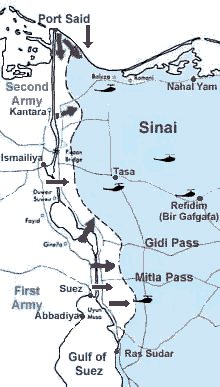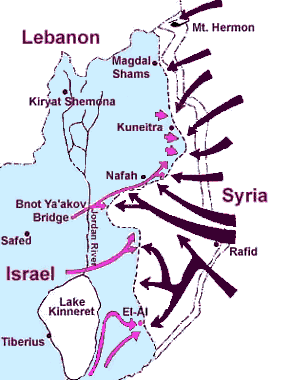Myths & Facts Online - The 1973 War
“Israel was responsible for the 1973 war.”
“Anwar Sadat agreed to U.S. peace proposals and did not seek war.”
“Egypt and Syria were the only Arab states involved in the 1973 war.”
“Israel was responsible for the 1973 war.”
FACT
On October 6, 1973 — Yom Kippur, the holiest day in the Jewish calendar — Egypt and Syria opened a coordinated surprise attack against Israel. The equivalent of the total forces of NATO in Europe was mobilized on Israel’s borders.1 On the Golan Heights, approximately 180 Israeli tanks faced an onslaught of 1,400 Syrian tanks. Along the Suez Canal, fewer than 500 Israeli defenders were attacked by 80,000 Egyptians.
 |
Thrown onto the defensive during the first two days of fighting, Israel mobilized its reserves and eventually repulsed the invaders and carried the war deep into Syria and Egypt. The Arab states were swiftly resupplied by sea and air from the Soviet Union, which rejected United States efforts to work toward an immediate ceasefire. As a result, the United States belatedly began its own airlift to Israel. Two weeks later, Egypt was saved from a disastrous defeat by the UN Security Council, which had failed to act while the tide was in the Arabs’ favor.
 |
The Soviet Union showed no interest in initiating peacemaking efforts while it looked like the Arabs might win. The same was true for UN Secretary-General Kurt Waldheim.
On October 22, the Security Council adopted Resolution 338 calling for “all parties to the present fighting to cease all firing and terminate all military activity immediately.” The vote came on the day that Israeli forces cut off and isolated the Egyptian Third Army and were in a position to destroy it.2
Despite the Israel Defense Forces' ultimate success on the battlefield, the war was considered a diplomatic and military failure. A total of 2,688 Israeli soldiers were killed.
“Egyptian President Anwar Sadat had agreed to U.S. peace proposals and did not seek war.”
FACT
In 1971, Egyptian President Anwar Sadat raised the possibility of signing an agreement with Israel, provided that all the occupieddisputed territories were returned by the Israelis. No progress toward peace was made, however, so, the following year, Sadat said war was inevitable and he was prepared to sacrifice one million soldiers in the showdown with Israel.3 His threat did not materialize that year.
Throughout 1972, and for much of 1973, Sadat threatened war unless the United States forced Israel to accept his interpretation of Resolution 242 — total Israeli withdrawal from territories taken in 1967.
Simultaneously, the Egyptian leader carried on a diplomatic offensive among European and African states to win support for his cause. He appealed to the Soviets to bring pressure on the United States and to provide Egypt with more offensive weapons to cross the Suez Canal. The Soviet Union was more interested in maintaining the appearance of détente with the United States than in confrontation in the Middle East; therefore, it rejected Sadat’s demands. Sadat’s response was to abruptly expel approximately 20,000 Soviet advisers from Egypt.
In an April 1973 interview, Sadat again warned he would renew the war with Israel.4 But it was the same threat he had made in 1971 and 1972, and most observers remained skeptical.
The United States agreed with Israel's view that Egypt should engage in direct negotiations. The U.S.-sponsored truce was three-years-old and Secretary of State Henry Kissinger had opened a new dialogue for peace at the UN. Almost everyone was confident the prospect of a new war was remote.
Sadat reacted acidly to Kissinger’s initiative:
The United States is still under Zionist pressure. The glasses the United States is wearing on its eyes are entirely Zionist glasses, completely blind to everything except what Israel wants. We do not accept this.5
“All countries should wage war against the Zionists, who are there to destroy all human organizations and to destroy civilization and the work which good people are trying to do.” — King Faisal of Saudi Arabia6 |
“Egypt and Syria were the only Arab states involved in the 1973 war.”
FACT
At least nine Arab states, including four non-Middle Eastern nations, actively aided the Egyptian-Syrian war effort.
A few months before the Yom Kippur War, Iraq transferred a squadron of Hunter jets to Egypt. During the war, an Iraqi division of some 18,000 men and several hundred tanks was deployed in the central Golan and participated in the October 16 attack against Israeli positions.7 Iraqi MiGs began operating over the Golan Heights as early as October 8, the third day of the war.
Besides serving as financial underwriters, Saudi Arabia and Kuwait committed men to battle. A Saudi brigade of approximately 3,000 troops was dispatched to Syria, where it participated in fighting along the approaches to Damascus. Also, violating Paris’s ban on the transfer of French-made weapons, Libya sent Mirage fighters to Egypt (from 1971-1973, Libyan President Muammar Qaddafi gave Cairo more than $1 billion in aid to rearm Egypt and to pay the Soviets for weapons delivered).8
Other North African countries responded to Arab and Soviet calls to aid the frontline states. Algeria sent three aircraft squadrons of fighters and bombers, an armored brigade and 150 tanks. Approximately 1,000-2,000 Tunisian soldiers were positioned in the Nile Delta. The Sudan stationed 3,500 troops in southern Egypt, and Morocco sent three brigades to the front lines, including 2,500 men to Syria.
Lebanese radar units were used by Syrian air defense forces. Lebanon also allowed Palestinian terrorists to shell Israeli civilian settlements from its territory. Palestinians fought on the Southern Front with the Egyptians and Kuwaitis.9
Theleast enthusiastic participant in the October fighting was probably Jordan's King Hussein, who apparently had been kept uninformed of Egyptian and Syrian war plans. But Hussein did send two of his best units — the 40th and 60th Armored Brigades — to Syria. This force took positions in the southern sector, defending the main Amman-Damascus route and attacking Israeli positions along the Kuneitra-Sassa road on October 16. Three Jordanian artillery batteries also participated in the assault, carried out by nearly 100 tanks.10
Syrian Minister of Defense Mustafa Tlas told the Syrian National Assembly in December 1973 of the following example of "supreme valor" by Syrian troops: “There is the outstanding case of a recruit from Aleppo who murdered 28 Jewish soldiers all by himself, slaughtering them like sheep. All of his comrades in arms witnessed this. He butchered three of them with an ax and decapitated them....He struggled face to face with one of them and throwing down his ax managed to break his neck and devour his flesh in front of his comrades. This is a special case. Need I single it out to award him the Medal of the Republic. I will grant this medal to any soldier who succeeds in killing 28 Jews, and I will cover him with appreciation and honor his bravery.”11 |
Notes
1Chaim Herzog, The Arab-Israeli Wars, (NY: Random House, 1984), p. 230.
2Herzog, p. 280.
3Howard Sachar, A History of Israel: From the Rise of Zionism to Our Time, (NY: Alfred A. Knopf, 1979), p. 747.
4Newsweek, (April 9, 1973).
5Radio Cairo, (September 28, 1973).
6Beirut Daily Star, (November 17, 1972).
7Trevor Dupuy, Elusive Victory: The Arab-Israeli Wars, 1947-1974, (NY: Harper & Row, 1978), p. 462.
8Dupuy, p. 376; Herzog, p. 278; Nadav Safran, Israel The Embattled Ally, (MA: Harvard University Press, 1981), p. 499.
9Herzog, p. 278, 285, 293; Dupuy, 534.
10Herzog, p. 300.
11Official Gazette of Syria, (July 11, 1974).
Maps: The Pedagogic Center, The Department for Jewish Zionist Education, The Jewish Agency for Israel, (c) 1997, 1998, 1999, 2000, Director: Dr. Motti Friedman, Webmaster: Esther Carciente.
See also: History of Israel
The 1973 War
Previous
Next
Table of Contents
Index
To order the paperback edition, click HERE.



